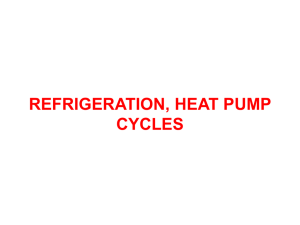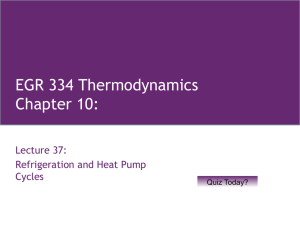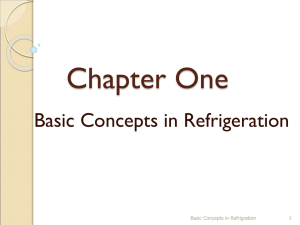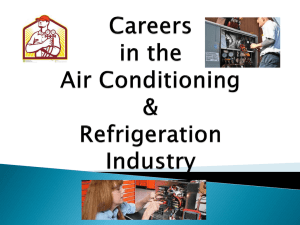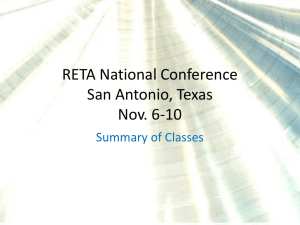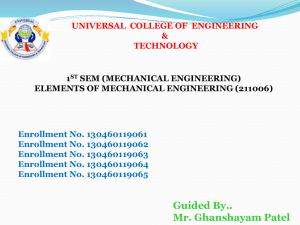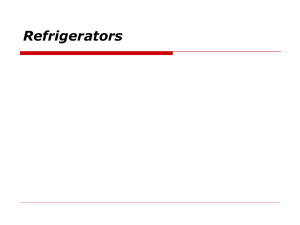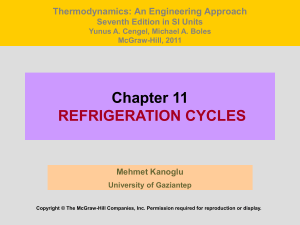Chapter 1 INTRODUCTION AND BASIC CONCEPTS
advertisement
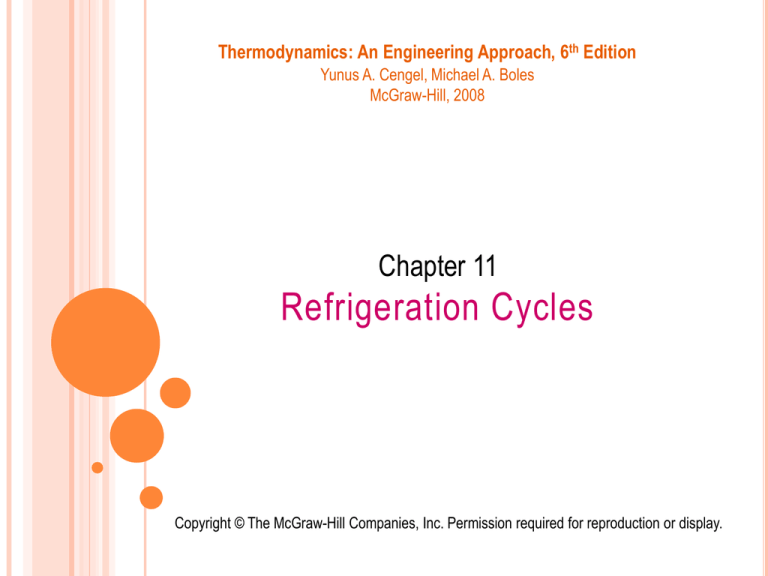
Thermodynamics: An Engineering Approach, 6th Edition Yunus A. Cengel, Michael A. Boles McGraw-Hill, 2008 Chapter 11 Refrigeration Cycles Copyright © The McGraw-Hill Companies, Inc. Permission required for reproduction or display. Objectives Introduce the concepts of refrigerators and heat pumps and the measure of their performance. Analyze the ideal and actual vapor-compression refrigeration cycles. Discuss the operation of refrigeration and heat pump systems. Evaluate the performance of innovative vapor-compression refrigeration systems. 2 Refrigerators And Heat Pumps The transfer of heat from a low-temperature region to a high-temperature one requires special devices called refrigerators. The objective of a refrigerator is to remove heat (QL) from the cold medium; the objective of a heat pump is to supply heat (QH) to a warm medium. Refrigerators and heat pumps are essentially the same devices; they differ in their objectives only. Performance: for fixed values of QL and QH 3 The most efficient refrigeration cycle operating between TL and TH. But not a suitable model for refrigeration cycles because: (i) process 2-3 involves compression of a liquid–vapor mixture requires a compressor that will handle two phases, (ii) process 4-1 involves expansion of highmoisture-content refrigerant in a turbine. The Reversed Carnot Cycle Both COPs increase as the difference between the two temperatures decreases, i.e. as TL rises or TH falls. Schematic of a Carnot refrigerator and T-s diagram of the reversed Carnot cycle. 4 Ideal Vapor-compression Refrigeration Cycle Is the ideal model for refrigeration systems. The refrigerant is vaporized completely before it is compressed and the turbine is replaced with a throttling device. The most widely used cycle for refrigerators, A-C systems, and heat pumps. Schematic and T-s diagram for the ideal vapor-compression refrigeration cycle. 5 The ideal vapor-compression refrigeration cycle involves an irreversible (throttling) process to make it a more realistic model for the actual systems. Steady-flow energy balance An ordinary household refrigerator. The P-h diagram of an ideal vaporcompression refrigeration cycle. 6 Problem Ideal and Actual Vapor-Compression Refrigeration Cycles 11–12 A refrigerator uses refrigerant-134a as the working fluid and operates on an ideal vapor-compression refrigeration cycle between 0.12 and 0.7 MPa. The mass flow rate of the refrigerant is 0.05 kg/s. Show the cycle on a T-s diagram with respect to saturation lines. Determine: a) the rate of heat removal from the refrigerated space, b) the power input to the compressor, c) the rate of heat rejection to the environment, and d) the coefficient of performance. Answers: (a) 7.41 kW, 1.83 kW, (b) 9.23 kW, (c) 4.06 7 Actual Vapor-Compression Refrigeration Cycle An actual vapor-compression refrigeration cycle involves irreversibilities in various components - mainly due to fluid friction (causes pressure drops) and heat transfer to or from the surroundings. As a result, the COP decreases. • • • • Differences Non-isentropic compression; Superheated vapor at evaporator exit; Sub-cooled liquid at condenser exit; Pressure drops in condenser and evaporator. Schematic and T-s diagram for the actual vapor-compression refrigeration cycle. 8 Problem – Class Exercise Ideal and Actual Vapor-Compression Refrigeration Cycles 11–15 Consider a 300 kJ/min refrigeration system that operates on an ideal vaporcompression refrigeration cycle with refrigerant-134a as the working fluid. The refrigerant enters the compressor as saturated vapor at 140 kPa and is compressed to 800 kPa. Show the cycle on a T-s diagram with respect to saturation lines, and determine the: a) quality of the refrigerant at evaporator inlet, b) coefficient of performance, and c) power input to the compressor. 9 Problem Ideal and Actual Vapor-Compression Refrigeration Cycles 11–18 Refrigerant-134a enters the compressor of a refrigerator as superheated vapor at 0.14 MPa and 10°C at a rate of 0.12 kg/s, and it leaves at 0.7 MPa and 50°C. The refrigerant is cooled in the condenser to 24°C and 0.65 MPa, and it is throttled to 0.15 MPa. Disregarding any heat transfer and pressure drops in the connecting lines between the components, show the cycle on a T-s diagram with respect to saturation lines, and determine: a) the rate of heat removal from the refrigerated space, b) the power input to the compressor, c) the isentropic efficiency of the compressor, and d) the COP of the refrigerator. Answers: (a) 19.4 kW, 5.06 kW, (b) 82.5 percent, (c) 3.83 10 Selecting the Right Refrigerant Several refrigerants may be used in refrigeration systems such as chlorofluorocarbons (CFCs), ammonia, hydrocarbons (propane, ethane, ethylene, etc.), carbon dioxide, air (in the air-conditioning of aircraft), and even water (in applications above the freezing point). R-11, R-12, R-22, R-134a, and R-502 account for over 90 percent of the market. The industrial and heavy-commercial sectors use ammonia (it is toxic). R-11 is used in large-capacity water chillers serving A-C systems in buildings. R-134a is used in domestic refrigerators and freezers, as well as automotive air conditioners. R-22 is used in window air conditioners, heat pumps, air conditioners of commercial buildings, and large industrial refrigeration systems, and offers strong competition to ammonia. R-502 (a blend of R-115 and R-22) is the dominant refrigerant used in commercial refrigeration systems such as those in supermarkets. CFCs allow more ultraviolet radiation into the earth’s atmosphere by destroying the protective ozone layer and thus contributing to the greenhouse effect that causes global warming. Refrigerants that are friendly to the ozone layer have been developed. Two important parameters to be considered - the temperatures of the refrigerated space and the environment with which the refrigerant exchanges heat. 11 Innovative Vapor-compression Refrigeration Systems The simple vapor-compression refrigeration cycle is the most widely used refrigeration cycle, and is adequate for most refrigeration applications. The ordinary vapor-compression refrigeration systems are simple, inexpensive, reliable, and practically maintenance-free. However, for large industrial applications, efficiency (not simplicity) is the major concern. For some applications the simple vapor-compression refrigeration cycle is inadequate and needs to be modified. For moderately and very low temperature applications, some innovative refrigeration systems are used. The following cycles will be discussed: • Cascade refrigeration systems • Multistage compression refrigeration systems • Multipurpose refrigeration systems with a single compressor • Liquefaction of gases 12 Cascade Refrigeration Systems • Some industrial applications require moderately low temperatures, and the temperature range they involve may be too large for a single vapor compression refrigeration cycle to be practical. • A large temperature range also means a large pressure range in the cycle and a poor performance for a reciprocating compressor. • One way of dealing with such situations is to perform the refrigeration process in stages, that is, to have two or more refrigeration cycles that operate in series. • Such refrigeration cycles are called cascade refrigeration cycles. 13 Cascade Refrigeration Systems A two-stage cascade refrigeration cycle is shown. The two cycles are connected through the heat exchanger in the middle, which serves as the evaporator for the topping cycle and the condenser for the bottoming cycle. A two-stage A two-stage cascade compression refrigeration refrigeration system with system the same with refrigerant a flash chamber. in both stages. 14 Cascade Refrigeration Systems • Assuming the heat exchanger is well insulated and the kinetic and potential energies are negligible, the heat transfer from the fluid in the bottoming cycle should be equal to the heat transfer to the fluid in the topping cycle. • Thus, the ratio of mass flow rates through each cycle should be • The coefficient of performance of the cascade system is 15 Problem Cascade Refrigeration Systems 11–42 Consider a two-stage cascade refrigeration system operating between pressure limits of 0.8 and 0.14 MPa. Each stage operates on the ideal vapor-compression refrigeration cycle with refrigerant-134a as the working fluid. Heat rejection from the lower cycle to the upper cycle takes place in an adiabatic counter-flow heat exchanger where both streams enter at about 0.4 MPa. If the mass flow rate of the refrigerant through the upper cycle is 0.24 kg/s, determine the: a) mass flow rate of the refrigerant through the lower cycle, b) rate of heat removal from the refrigerated space, c) power input to the compressor, and d) coefficient of performance of this cascade refrigerator. Answers: (a) 0.195 kg/s, (b) 34.2 kW, 7.63 kW, (c) 4.49 16 Problem Cascade Refrigeration Systems 11–47 Consider a two-stage cascade refrigeration system operating between pressure limits of 1.2 MPa and 200 kPa with refrigerant-134a as the working fluid. Heat rejection from the lower cycle to the upper cycle takes place in an adiabatic counter-flow heat exchanger where the pressure in the upper and lower cycles are 0.4 and 0.5 MPa, respectively. In both cycles, the refrigerant is a saturated liquid at the condenser exit and a saturated vapor at the compressor inlet, and the isentropic efficiency of the compressor is 80 percent. If the mass flow rate of the refrigerant through the lower cycle is 0.15 kg/s, determine the: a) mass flow rate of the refrigerant through the upper cycle, b) rate of heat removal from the refrigerated space, and c) coefficient of performance of the system. Answers: (a) 0.212 kg/s, (b) 25.7 kW, (c) 2.68 17 Multistage Compression Refrigeration Systems When the fluid used throughout the cascade refrigeration system is the same, the heat exchanger between the stages can be replaced by a mixing chamber (called a flash chamber) since it has better heat transfer characteristics. A two-stage compression refrigeration system with a flash chamber. 18 Problem Two-Stage Compression Refrigeration Systems 11–44 A two-stage compression refrigeration system operates with refrigerant-134a between the pressure limits of 1 and 0.14 MPa. The refrigerant leaves the condenser as a saturated liquid and is throttled to a flash chamber operating at 0.5 MPa. The refrigerant leaving the low-pressure compressor at 0.5 MPa is also routed to the flash chamber. The vapor in the flash chamber is then compressed to the condenser pressure by the high-pressure compressor, and the liquid is throttled to the evaporator pressure. Assuming the refrigerant leaves the evaporator as saturated vapor at a rate of 0.25 kg/s and that both compressors are isentropic, determine the: a) fraction of the refrigerant that evaporates in the flash chamber, b) rate of heat removed from the refrigerated space, and c) coefficient of performance. 19 Problem Two-Stage Compression Refrigeration System 11–48 A two-stage cascade refrigeration system operates between pressure limits of 1.2 MPa and 200 kPa with refrigerant-134a as the working fluid. Saturated liquid refrigerant leaving the condenser is throttled to a flash chamber operating at 0.45 MPa. The vapor from the flash chamber is mixed with the refrigerant leaving the low-pressure compressor. The mixture is then compressed to the condenser pressure by the high-pressure compressor. The liquid in the flash chamber is throttled to the evaporator pressure. The mass flow rate of the refrigerant is 0.15 kg/s. Assuming saturated vapor refrigerant leaves the evaporator and the isentropic efficiency is 80 percent for both compressors, determine the: a) mass flow rate of refrigerant in the high-pressure compressor, b) rate of heat removal from the refrigerated space, and c) coefficient of performance of the system. d) rate of heat removal and the COP if this refrigerator operated on a singlestage cycle between the same pressure limits with the same compressor efficiency and flow rate as in part (a). 20 Absorption Refrigeration Systems When there is a source of inexpensive thermal energy at a temperature of 100 to 200°C is absorption refrigeration. Some examples include geothermal energy, solar energy, and waste heat from cogeneration or process steam plants, and even natural gas when it is at a relatively low price. 21 Ammonia absorption refrigeration cycle. Absorption refrigeration systems (ARS) involve the absorption of a refrigerant by a transport medium. The most widely used system is the ammonia–water system, where ammonia (NH3) serves as the refrigerant and water (H2O) as the transport medium. Other systems include water–lithium bromide and water–lithium chloride systems, where water serves as the refrigerant. These systems are limited to applications such as A-C where the minimum temperature is above the freezing point of water. Compared with vapor-compression systems, ARS have one major advantage: A liquid is compressed instead of a vapor and as a result the work input is very small (on the order of one percent of the heat supplied to the generator) and often neglected in the cycle analysis. ARS are much more expensive than the vapor-compression refrigeration systems. They are more complex and occupy more space, they are much less efficient thus requiring much larger cooling towers to reject the waste heat, and they are more difficult to service since they are less common. Therefore, ARS should be considered only when the unit cost of thermal energy is low and is projected to remain low relative to electricity. 22 ARS are primarily used in large commercial and industrial installations. The COP of actual absorption refrigeration systems is usually less than unity. Air-conditioning systems based on absorption refrigeration, called the absorption chillers, perform best when the heat source can supply heat at a high temperature with little temperature drop. The maximum COP of an absorption refrigeration system. 23

